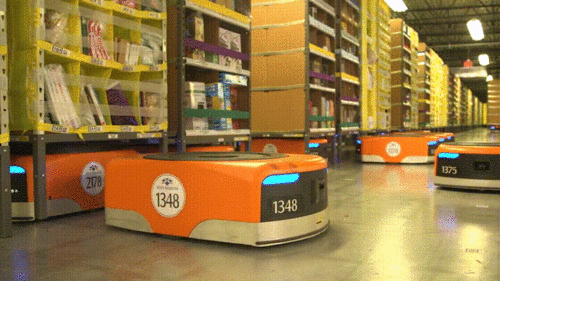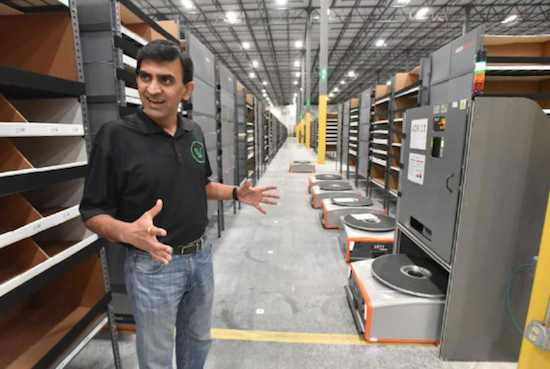
Automation: Warehouse Work Is Increasingly Done by Robots
05/31/2019
A major reason why Amazon honcho Jeff Bezos is the richest man in the world ($132B in 2018) was his early adoption of robots in his warehouses — see my 2016 article Amazon Robotics in The Social Contract for background.
Below, the Kiva robots of Amazon scoot under the appropriate rack of merchandise and bring it to a human packer for shipment.

Jeff Bezos purchased the Kiva robotic system for $775 million in 2012, but rather than farm out the smart machines to other businesses, he kept them in house to hold his advantage.
Therefore it’s not surprising that knock-off machines have been designed to fill the desire of business owners to run their warehouses as cheaply as possible. One is from the GreyOrange company of Asia:
Keep in mind that whenever robots become less expensive than workers, the humans will be replaced. So it makes no sense to continue importing low-skilled foreigners via immigration when it has become clear that the future will be operated by smart machines. In fact …
Automation makes immigration obsolete.
Here’s a story about the knock-off warehouse robots:
Robots are taking on more warehouse jobs, Bend Bulletin, May 28, 2019

Padmanabhan Raman, chief production manager, shows off charging station at Project Verte in McDonough, Georgia, on May 2.
ATLANTA — Tephnee Usher stands in a McDonough, Georgia, warehouse, separated from the stored goods by a black chain-link fence, and waits for robots to deliver the goods to her.
Human workers are confined to opposite edges of this 17-acre roofed space: delivery bays and shipping bays about a football field apart. The vast concrete area between them belongs to 225 electric powered, eerily silent robotic Butlers that perform tasks people used to do.
E-commerce, growing at 15 percent a year, is driving a second boom in Georgia’s robust warehousing and logistics industry, which employs about 118,000 packers and material handlers across the state. Companies setting up ready-to-ship warehouses here last year included Target’s furniture line, Wayfair home furnishings and Dynacraft bikes and scooters. Amazon has four “fulfillment” centers scattered from Braselton to Macon.
It’s clear the industry is changing. What’s less clear is how much that will translate into a jobs boom or bust as automation and artificial intelligence increasingly take over the work.
The robot-powered warehouse in McDonough just south of Atlanta will begin operations in June after test runs. It belongs to Verte, a Sandy Springs, Georgia, start-up aiming to compete with Amazon. Verte targets mom-and-pop to midsize sellers, offering to help them track, keep inventory, sell and move their goods ranging from shoes to cosmetics from manufacturer to home.
The low-slung Butlers are manufactured by GreyOrange in Alpharetta, Georgia, the American headquarters of the Singapore company. It can retrofit any warehouse with a flat floor into a roboticized one that can endlessly reconfigure its movable shelves for maximum efficiency. Products that arrive at one door can be stocked and on their way to buyers in as little as two hours, touched by human hands only two or three times.
The Butlers at the McDonough warehouse look like giant Roombas, the disc-shaped robotic vacuum cleaners. They glide among 6,000 refrigerator-size shelving units lined up in rows 85 deep between the delivery and shipping bays. They roll precisely under a unit holding an item someone has ordered, jack it up with enough electric power to lift more than 3,000 pounds, and move it to the waiting Usher, a human picker.
Usher then grabs the item out of one of its bins, scans it and hands it to team members who pack it and label it for shipping to a customer’s home.
The warehouse is cutting edge when it comes to automation. But it isn’t alone. E-commerce giant Amazon is adding highly roboticized warehouses across the nation similar to Verte’s. The closest one to Georgia is in Jacksonville, Florida, which uses movable shelving units and scooter-like robots that look like GreyOrange’s.
Repetitive work, like warehouse jobs, is widely predicted to be among those more vulnerable to disappearing thanks to robots and artificial intelligence.
At the same time, new jobs are created through the industry’s growth and adoption of technology.
Programmers and robot mechanics are now on staffs, but they typically take more education or skills. There is unsettled debate about whether continuing technological and social changes will create as many jobs as those shorn off.
“I think there’s definitely going to be fewer workers in warehouses, but warehouses are also experiencing labor shortages,” said Nancey Green Leigh, a Georgia Tech professor who studies robots and works with a National Science Foundation grant.
Packing goods for shipping is often tedious work at low pay, which has led to employee turnover and unfilled jobs. With the unemployment rate below 4 percent, there also are fewer available workers. Indeed.com lists more than 6,000 warehouse jobs in Georgia, the bulk of them paying $25,000 a year or less.
“On the one hand, we can be concerned about the job loss, but on the other hand, many of the jobs are not great jobs,” said Green Leigh.
Georgia long has been a logistics and warehousing center.
Atlanta has the sixth-most warehousing space among metro areas, with 683 million square feet. It is home to companies such as UPS and Manhattan Associates and has major operations for big global logistics providers such as XPO.
Hartsfield-Jackson International Airport is a cargo hub and Savannah is the fourth-busiest U.S. container port in the U.S., connecting Georgia businesses to the world. The state boasts excellent rail and interstate access.
Verte, backed by $45 million in venture capital, is hoping to leapfrog larger and older competitors with the help of GreyOrange’s robots. GreyOrange, also a startup, has received more than $170 million in venture capital.
“Anybody who built five or 10 years ago was too early,” said Verte founder Julian Kahlon, in reference to fast-changing technology.
Kahlon added that he wanted to build a warehouse capable of doing Black Friday business volumes every day, to keep up with the explosion in demand as consumers increasingly opt to have goods shipped directly to their homes.
Low-skilled warehouse work is not well paid, the average job paying about $13 an hour, according to the Georgia Department of Labor. And the work can be arduous. Before mobile delivery robots, pickers could walk up to 12 miles a day finding and moving items, said Green Leigh, the Georgia Tech professor.
But the drive for efficiency means companies also are searching for additional ways to replace humans with robots. Both Amazon and GreyOrange say they have built and are perfecting picking robots — the same job that Usher is currently doing at Verte’s McDonough warehouse.
Amazon also has a test delivery program in Washington state, where a wheeled robot traveling on sidewalks is delivering packages to doorsteps, and has made investments in self-driving vehicles, including shipping trucks. (Continues)
